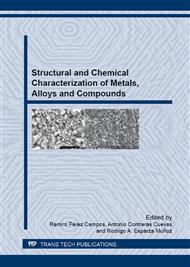[1]
D. O, Evaluation of Stress-Corrosion Cracking, in Metals Handbook. Ninth Edition. Vol. 13, Corrosion. Metals Park, OH: ASM International, (1987).
Google Scholar
[2]
M.M. Hall Jr., Critique of the Ford–Andresen film rupture model for aqueous stress corrosion cracking, Corros. Sci. 51 (2009) 1103-1106.
DOI: 10.1016/j.corsci.2009.02.022
Google Scholar
[3]
S. Pal, R. N. Ibrahim, Role of Bayer solution concentration and temperature in stress corrosion cracking susceptibility of steel, Corros. Sci. 53 (2011) 2660-2669.
DOI: 10.1016/j.corsci.2011.05.005
Google Scholar
[4]
A.A. Oskuie, T. Shahrabi, A. Shahriari, E. Saebnoori, Electrochemical impedance spectroscopy analysis of X70 pipeline steel stress corrosion cracking in high pH carbonate solution, Corros. Sci. 61 (2012) 111-122.
DOI: 10.1016/j.corsci.2012.04.024
Google Scholar
[5]
T. Haruna, T. Shibata and R. Toyota, Initiation and propagation of stress corrosion cracks for type 3041 stainless steel in chloride solutions containing thiosulfate, Corros. Sci. 39 (1997) 1935-(1947).
DOI: 10.1016/s0010-938x(97)00087-5
Google Scholar
[6]
G.A. Zhang, Y.F. Cheng, Micro-electrochemical characterization and Mott–Schottky analysis of corrosion of welded X70 pipeline steel in carbonate/bicarbonate solution, Electrochimica Acta 55 (2009) 316-324.
DOI: 10.1016/j.electacta.2009.09.001
Google Scholar
[7]
Z.Y. Liu, X.G. Li, C.W. Du, G.L. Zhai, Y.F. Cheng, Stress corrosion cracking behavior of X70 pipe steel in an acidic soil environment, Corros. Sci. 50 (2008) 2251-2257.
DOI: 10.1016/j.corsci.2008.05.011
Google Scholar
[8]
R. W. Bosch, Electrochemical impedance spectroscopy for the detection of stress corrosion cracks in aqueous corrosion systems at ambient and high temperature, Corros. Sci. 47 (2005) 125-143.
DOI: 10.1016/j.corsci.2004.05.018
Google Scholar
[9]
X. Lou, P. M. Singh, Phase angle analysis for stress corrosion cracking of carbon steel in fuel-grade ethanol: Experiments and simulation, Electrochimica Acta. 56 (2011) 1835-1847.
DOI: 10.1016/j.electacta.2010.07.024
Google Scholar
[10]
P. Kentish, Stress corrosion cracking of gas pipelines – Effect of surface roughness, orientations and flattening, Corros. Sci. 49 (2007) 2521-2533.
DOI: 10.1016/j.corsci.2006.12.014
Google Scholar
[11]
T. Shoji, Z. Lu, H. Murakami, Formulating stress corrosion cracking growth rates by combination of crack tip mechanics and crack tip oxidation kinetics, Corros. Sci. 52 (2010) 769-779.
DOI: 10.1016/j.corsci.2009.10.041
Google Scholar
[12]
S. Ramamurthy, W.M.L. Lau, A. Atrens, Influence of the applied stress rate on the stress corrosion cracking of 4340 and 3. 5NiCrMoV steels under conditions of cathodic hydrogen charging, Corros. Sci. 53 (2011) 2419-2429.
DOI: 10.1016/j.corsci.2011.03.028
Google Scholar
[13]
Y.F. Cheng, Fundamentals of hydrogen evolution reaction and its implications on near-neutral pH stress corrosion cracking of pipelines, Electrochimica Acta 52 (2007) 2661-2667.
DOI: 10.1016/j.electacta.2006.09.024
Google Scholar
[14]
J.J. Park, S.I. Pyun, K.H. Na, S.M. Lee, Y.T. Kho, Effect of passivity of the oxide film on low-pH stress corrosion cracking of API 5L X65 pipeline steel in bicarbonate solution, Corrosion 58 (2002) 329-336.
DOI: 10.5006/1.3287682
Google Scholar
[15]
R. Oltra, M. Keddam, Application of impedance technique to localized corrosion, Corros. Sci. 28 (1988) 1-18.
DOI: 10.1016/0010-938x(88)90002-9
Google Scholar
[16]
R. De Levie, in: P. Delahay and W. Tobias (Eds. ), Advances in Electrochemistry and Electrochemical Engineering, N.Y., (1967) p.329.
Google Scholar
[17]
M.C. Petit, M. Cid, M. Puiggali, Z. Amor, An impedance study of the passivity breakdown during stress corrosion cracking phenomena, Corros. Sci. 31 (1990) 491-496.
DOI: 10.1016/0010-938x(90)90151-t
Google Scholar
[18]
R.W. Bosch, F. Moons, J.H. Zheng, W.F. Bogaerts, Application of electrochemical impedance spectroscopy for monitoring stress corrosion cracking, Corrosion 57 (2001) 532-539.
DOI: 10.5006/1.3290379
Google Scholar
[19]
M.C. Li, Y.F. Cheng, Corrosion of the stressed pipe steel in carbonate–bicarbonate solution studied by scanning localized electrochemical impedance spectroscopy, Electrochimica Acta 53 (2008) 2831-2836.
DOI: 10.1016/j.electacta.2007.10.077
Google Scholar
[20]
G.A. Zhang, Y.F. Cheng, Micro-electrochemical characterization of corrosion of welded X70 pipeline steel in near-neutral pH solution, Corrosion Sci. 51 (2009) 1714-1724.
DOI: 10.1016/j.corsci.2009.04.030
Google Scholar
[21]
J. Kovac, C. Alaux, T.J. Marrow, E. Govekar, A. Legat, Correlations of electrochemical noise, acoustic emission and complementary monitoring techniques during intergranular stress-corrosion cracking of austenitic stainless steel, Corros. Sci. 52 (2010).
DOI: 10.1016/j.corsci.2010.02.035
Google Scholar
[22]
G. Du, J. Li, W.K. Wang, C. Jiang, S.Z. Song, Detection and characterization of stress-corrosion cracking on 304 stainless steel by electrochemical noise and acoustic emission techniques, Corros. Sci. 53 (2011) 2918-2926.
DOI: 10.1016/j.corsci.2011.05.030
Google Scholar
[23]
J. B. Jorcin, M. E. Orazem, N. Pebere, B. Tribollet, CPE analysis by local electrochemical impedance spectroscopy, Electrochimica Acta 51 (2006) 1473-1479.
DOI: 10.1016/j.electacta.2005.02.128
Google Scholar
[24]
J. B. Allen and L. R. Faulkenr: Electrochemical Methods Fundamentals and Applications, United States of America: John Wiley & Sons, First Edition, (1980).
Google Scholar
[25]
E. E. Stansbury, R. A. Buchanan: Fundamentals of Electrochemical Corrosion, United States of America: ASM International, first Edition, (2000).
Google Scholar


